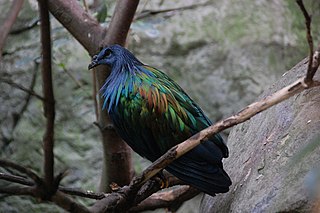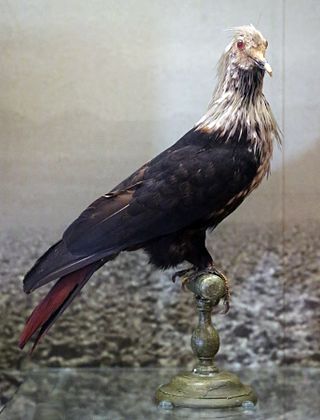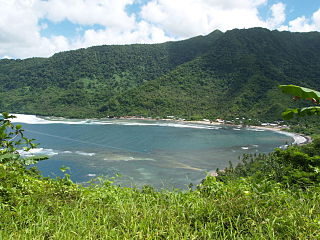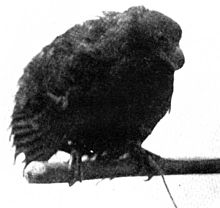
The dodo is an extinct flightless bird that was endemic to the island of Mauritius, which is east of Madagascar in the Indian Ocean. The dodo's closest relative was the also-extinct and flightless Rodrigues solitaire. The two formed the subfamily Raphinae, a clade of extinct flightless birds that were a part of the family which includes pigeons and doves. The closest living relative of the dodo is the Nicobar pigeon. A white dodo was once thought to have existed on the nearby island of Réunion, but it is now believed that this assumption was merely confusion based on the also-extinct Réunion ibis and paintings of white dodos.

Columbidae is a bird family consisting of doves and pigeons. It is the only family in the order Columbiformes. These are stout-bodied birds with short necks and short slender bills that in some species feature fleshy ceres. They primarily feed on plants, and can be taxonomically divided amongst granivores, that feed mostly on the ground on seeds, and frugivores, that feed mostly on fruits, from branches. The family occurs worldwide, often in close proximity with humans, but the greatest variety is in the Indomalayan and Australasian realms.

The Rodrigues solitaire is an extinct flightless bird that was endemic to the island of Rodrigues, east of Madagascar in the Indian Ocean. Genetically within the family of pigeons and doves, it was most closely related to the also extinct dodo of the nearby island Mauritius, the two forming the subfamily Raphinae. The Nicobar pigeon is their closest living genetic relative.

The Nicobar pigeon or Nicobar dove is a bird found on small islands and in coastal regions from the Andaman and Nicobar Islands, India, east through the Indonesian Archipelago, to the Solomons and Palau. It is the only living member of the genus Caloenas alongside the extinct spotted green pigeon and Kanaka pigeon, and is the closest living relative of the extinct dodo and Rodrigues solitaire.

The Raphinae are a clade of extinct flightless birds formerly called didines or didine birds. They inhabited the Mascarene Islands of Mauritius and Rodrigues, but became extinct through hunting by humans and predation by introduced non-native mammals following human colonisation in the 17th century. Historically, many different groups have been named for both the dodo and the Rodrigues solitaire, not all grouping them together. Most recently, it is considered that the two birds can be classified in Columbidae, often under the subfamily Raphinae. The first person to suggest a close affinity to the doves was Johannes Theodor Reinhardt, whose opinions were then supported by Hugh Edwin Strickland and Alexander Gordon Melville.

The Choiseul pigeon is an extinct species of bird in the pigeon and dove family, Columbidae. It was endemic to the island of Choiseul in the Solomon Islands, although there are unsubstantiated reports that it may once have lived on several nearby islands. The last confirmed sighting was in 1904. Other common names were Solomons crested pigeon, Solomon Islands crowned-pigeon and Kuvojo.

The Mauritius blue pigeon is an extinct species of blue pigeon formerly endemic to the Mascarene island of Mauritius in the Indian Ocean east of Madagascar. It has two extinct relatives from the Mascarenes and three extant ones from other islands. It is the type species of the genus of blue pigeons, Alectroenas. It had white hackles around the head, neck and breast and blue plumage on the body, and it was red on the tail and the bare parts of the head. These colours were thought similar to those of the Dutch flag, a resemblance reflected in its French common name, Pigeon Hollandais. The juveniles may have been partially green. It was 30 cm (12 in) long and larger and more robust than any other blue pigeon species. It fed on fruits, nuts, and molluscs, and was once widespread in the forests of Mauritius.
Tafua is a seaside village on the island of Savai'i in Samoa. It is situated on a peninsula on the southeast coast of the island in Palauli district. The population is 406.

Uafato is a village on the north east coast of Upolu island in Samoa within the political district of Va'a-o-Fonoti. It has a population of 254. The village is part of a conservation zone called the Uafato Conservation Area with national and global significance as a unique cultural and conservation area.

The tooth-billed pigeons are the only genus (Didunculus) of the subfamily Didunculinae, in the pigeon and dove family, (Columbidae). It has no close living relatives, but it has been shown to be genetically close to the dodo, and the genus name Didunculus means "little dodo". The jaw and tongue structure, and the superficially parrotlike bill have suggested a relationship to the parrots, but these features have arisen from its specialised diet rather than any real relationship.

The blue pigeons are a genus, Alectroenas, of birds in the dove and pigeon family Columbidae. They are native to islands in the western Indian Ocean.

The mao or ma'oma'o is a passerine bird belonging to the genus Gymnomyza in the honeyeater family Meliphagidae. It is an endangered species and is endemic to the Samoan Islands.

Bird extinction is the complete elimination of all species members under the taxonomic class, Aves. Out of all known bird species,, 159 (1.4%) have become extinct, with 226 (2%) being critically endangered. There is a general consensus among ornithologists that if anthropogenic activities continue as current trends suggest, one-third of all bird species, and an even greater proportion of bird populations, will be rendered extinct by the end of the 21st century.

The spotted green pigeon or Liverpool pigeon is a species of pigeon which is most likely extinct. It was first mentioned and described in 1783 by John Latham, who had seen two specimens of unknown provenance and a drawing depicting the bird. The taxonomic relationships of the bird were long obscure, and early writers suggested many different possibilities, though the idea that it was related to the Nicobar pigeon prevailed, and it was therefore placed in the same genus, Caloenas. Today, the species is only known from a specimen kept in World Museum, Liverpool. Overlooked for much of the 20th century, it was recognised as a valid extinct species by the IUCN Red List only in 2008. It may have been native to an island somewhere in the South Pacific Ocean or the Indian Ocean, and it has been suggested that a bird referred to as titi by Tahitian islanders was this bird. In 2014, a genetic study confirmed it as a distinct species related to the Nicobar pigeon, and showed that the two were the closest relatives of the extinct dodo and Rodrigues solitaire.

Nuʻulua is an island in Samoa. It is located in the Aleipata Islands, somewhat more than 1.3 km from the eastern end of Upolu.

The Samoan tropical moist forests are a tropical moist broadleaf forest ecoregion in the Samoan Islands of the Pacific Ocean.

The Mascarene grey parakeet, Mauritius grey parrot, or Thirioux's grey parrot, is an extinct species of parrot which was endemic to the Mascarene Islands of Mauritius and Réunion in the western Indian Ocean. It has been classified as a member of the tribe Psittaculini, along with other parrots from the Islands.
The Samoa Conservation Society is an environmental organisation based in Samoa. Its purpose is to promote the conservation of Samoa’s biological diversity and natural heritage. The society is active in efforts to save the critically-endangered Manumea, Samoa's national bird, and in forest restoration.

The Tongan tooth-billed pigeon, is an extinct species of pigeon that was endemic to Tonga that lived in the Quaternary period. A related species, the tooth-billed pigeon, is the only known living species in its genus.





















